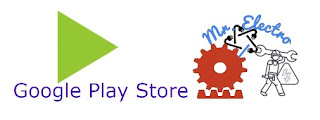AC generator is an electrical machine which convert rotating power into AC electrical power. There are two types of AC generator i.e. induction generator and synchronous generator. AC generator is also called as synchronous generator or alternator. First of all, water come from dam or reservoir through penstock and hit turbine. Turbine will change potential energy of water into kinetic energy by rotating blades i.e. mechanical power. AC Generator shaft is connected to turbine shaft using different mean and AC generator will convert mechanical power into electrical power. An alternating voltage is generated in a conductor of armature if armature coil is rotating in magnetic field and field poles are stationary. Similarly, if armature is stationary and field poles are rotating, alternating voltage will also generated in conductor of armature. It means, any of these methods can be used to generate electricity or produce voltage. Mostly second method is used in AC generator or synchronous generator. For larger power like at thermal, hydro, nuclear power plant, it is generally used and power rating start from small power to several hundred MVA.
Advantage of rotating field in AC generator
Construction of AC generator / synchronous generator
Synchronous generator consists of stator and rotor whereas stator is stationary part that contains armature coil and rotor is rotating part that contains field pole. The output is taken from armature.
1. Stator construction
It is stationary part of AC generator which includes generator frame, stator core, winding etc. It is made of cast iron for small size and sheet steel for large machine. Its core is laminated with silicon content steel to reduce hysteresis loss and eddy current loss. On armature frame, there is a slots where armature winding is placed. Output is taken from that 3 phase armature winding.
2. Rotor construction
There are 2 types of rotor for AC generator/synchronous generator i.e. salient pole rotor and non-salient pole rotor.
Salient pole rotor consists of a number of poles on rotor's surface. Normally, there are more than 4 poles and made of thin steel lamination for reducing eddy current loss. All poles must be identical and fitted on the steel spider(rotor surface). On poles, winding is done for excitation (for flux production by passing current on that field winding). Generally, damper bars are placed at the end of pole (pole face) to damp out the rotor oscillation while sudden change in load. On this rotor construction, air gap is non-linear as air gap increase from pole center to pole tips. That helps in flux distribution in the air gap which make it sinusoidal and helps the synchronous generator to generate sinusoidal emf. The field pole winding are connected in series form so it can be connected to DC source for excitation. This is mainly used for lower speed for power generation like in hydro power plant.
Cylindrical pole rotor is also known as non-salient pole rotor as it forms smooth cylinder. Physically, there is no poles seen and it is made of solid forgings of high grade nickel-chrome-molybdenum steel. Slots are cut on regular interval at about two third parts of periphery of rotor where winding are done on it. Slots are parallel to the rotor shaft and the unslotted part of opposite side acts as pole faces. As it has no physical pole, its diameter is small as compared to salient pole rotor but has longer axial length. It has uniform air gap on slots that make low noise while operating. This is mainly used for high speed for power generation like in steam power plant.
There are slip ring and carbon brush which is used for power supply to the field winding. These generator are horizontally and vertically configured. Generally, the generator of salient pole rotor have vertical configuration and the generator of non-salient pole rotor have horizontal configuration.







No comments:
Post a Comment
----Please share your opinion with us-----